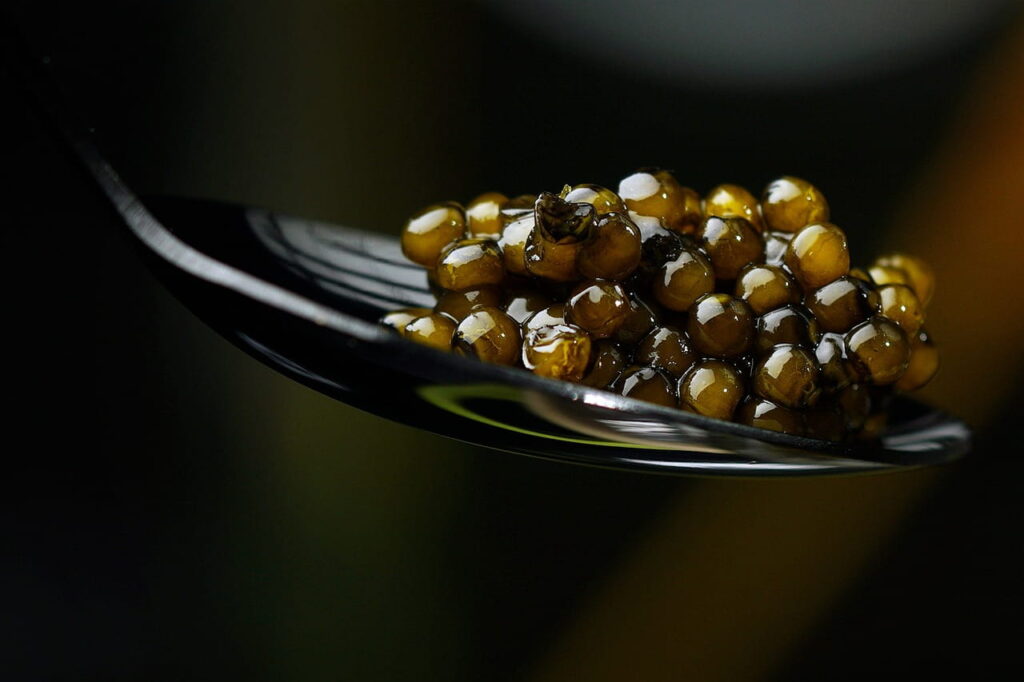Traditionally the salted eggs (roe) of a sturgeon fish, it is a delicacy that has been savoured for centuries by royalty and people of upmost class. Hence why, caviar is renowned with it’s luxurious status and symbolized as something of wealth. This is due to the limited supply of sturgeon fish and the crucial caviar harvesting methods.
The origins of fish roe date back to the Persian Empire, where fishermen along the Caspian Sea first discovered sturgeon eggs. Over time, caviar became a delicacy favoured by royalty, especially in Russian and European courts.
Today, it remains a symbol of luxury and indulgence worldwide.
Caviar refers specifically to the eggs, or roe, of sturgeon fish, traditionally harvested from species like Beluga, Oscietra, and Sevruga. These small, delicate eggs are salted and carefully processed to preserve their rich flavour and texture. This is why sturgeon roe is considered caviar. Though roe from other fish, such as salmon or trout, is sometimes referred to as caviar, only the truest form is sturgeon caviar.
Origins of Caviar
Forms of Premium Caviar primarily originates from the Caspian Sea, bordered by countries like Russia and Iran, where the number of sturgeons have thrived for centuries. These waters produce the world’s most wanted varieties of caviar, including the prestigious Beluga. Other significant regions include the Black Sea and certain parts of North America, where sustainable caviar farming has grown in popularity due to the different types of fish that live there..
History of Caviar is an interesting and very common way of entering the extravagant world. Along the Caspian and Baltics seas, many cultures have thrived and fought over caviar, it is embedded into the people and that it is why it is valuable. The caviar industry is the only place you are able to taste and enjoy traditions of all caviar in the world. You are able to find the highest quality caviar simply on Tsarscaviar.com.

The Evolution of Caviar Harvesting
Farming has a long and evolving history. Traditionally, the process required specialists to kill the fish in order to extract the precious roe, a method that led to a sharp decline in wild sturgeon populations, especially in the Caspian and Black Seas. As demand for caviar grew, this unsustainable practice threatened the survival of many sturgeon species.
In response to these environmental concerns, caviar production has shifted towards more sustainable methods. One such technique is no-kill harvesting, where the roe is carefully extracted without harming the sturgeon, allowing the fish to continue living and producing roe for future harvests. Popularity for this has risen, particularly in caviar farms across Europe, North America, and parts of Asia, ensuring a more ethical approach to production.
The evolution of these practices not only helps protect sturgeon populations but also guarantees a more sustainable supply of high-quality caviar for future generations.
So, Where is Caviar From?
Caviar’s journey from ancient delicacy to modern luxury tells a story of tradition, adaptation, and sustainability. From the earliest days of Beluga caviar, being prized by Persian fishermen to modernising wild caviar to no-kill harvesting methods used in today’s caviar hunting.
Whether enjoyed in its classic form from the Caspian Sea or sourced from sustainable fish farms across the globe, fish eggs remains a timeless symbol of wealth & traditionalism, appealing to those who seek the finest culinary experiences.
As the caviar industry continues to innovate, it ensures that this iconic delicacy will be enjoyed by future generations while safeguarding the fragile ecosystems it depends on.




